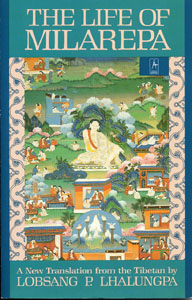DAVID RATHBUN
SOUTH HIGH SCHOOL, MINNEAPOLIS
WHERE IS MILAREPA IN WORLD LITERATURE?
HOME
To the people of Tibet and to fellow Buddhists in the Asian highlands and the Himalayas, Mila, although he lived in the twelfth century, is not a myth but still a vital figure--the embodiment of supreme excellence as well as the father of awakened masters. Never, in the thirteen centuries of Buddhist history in Tibet, has there been such a man, who not only inspired an intellectual elite and spiritual luminaries, but also captured the imagination of the common people.
The Life, on the whole, is genuine autobiography, a ritual drama recounting significant events in Mila's apprenticeship rather than his comments on them.
 from
"Introduction" to The Life of Milarepa, by Lobsang P.
Lhalungpa
from
"Introduction" to The Life of Milarepa, by Lobsang P.
Lhalungpa
THE PLOT: Although this book of 203 pages is not a novel, at times it reads like one. At a superficial level, it could even read as a revenge-thriller or action movie. Mila's father dies and leaves the young boy, his sister, and mother. With his last breath, the father requests Mila's aunt and uncle to take care of the family. Of course, they turn out to be monstrously cruel towards all of them. Eventually Mila's mother apprentices him to a shaman to learn magic spells. He learns well. The aunt and uncle don't get killed, but 35 other people die in what turns out to be a blood-wedding feast. Mila conjured a giant scorpion to bring the house down on them.
I am hopefully endeavoring to achieve liberation from the ocean of
existential bondage, from which escape is very difficult.
Soon after Mila seeks redemption through Buddhism. He goes through a series of trials and tribulations at the hands of his guru, Marpa. This spiritual odyssey is long and profoundly challenging. He at times gives up, but finally succeeds. Years of meditation in southwestern Tibet and western Nepal follow, punctuated by interactions with strangers, his sister, aunt and uncle, cousin, and his various disciples. During this time period he lived on roasted barley flour, dried meats, and nettles. The book shifts from a first-person point of view to third-person in the final chapters that record his death--at age 84--and funeral(s).
In summary, after the final departure for the Buddha realm of Milarepa, the greatest of saints, the story of his life became a clear
example of supreme liberation, and the result of his infinite compassion and universal concern was seen in the emergence of his spiritual
disciples.
| The Dharmapala Thangka Centre has a 15-page version of Milarepa's
life: http://www.bremen.de/info/nepal/Icono/Milarepa.htm
Eva va Dam, a Dutch artist and illustrator, has written a comic book version of his life, available in book form (Shambhala) and online: http://sealevel.ns.ca/milarepa/milarepaeva.html |
This site was created by DAVID RATHBUN at the NEH Summer Institute "Cultures and Religions of the Himalayan Region," held at the College of the Holy Cross, Summer 2004